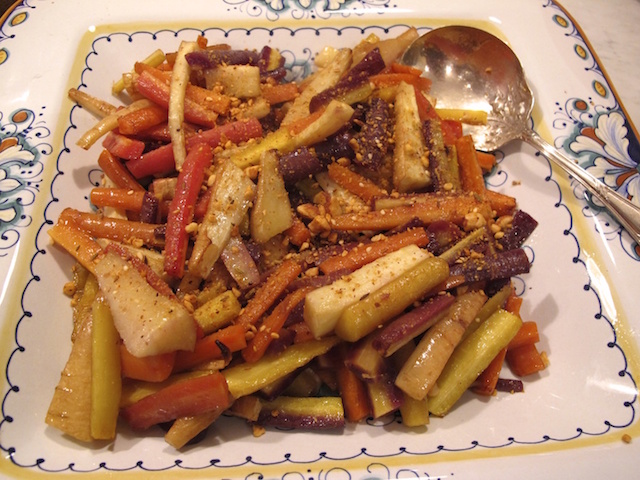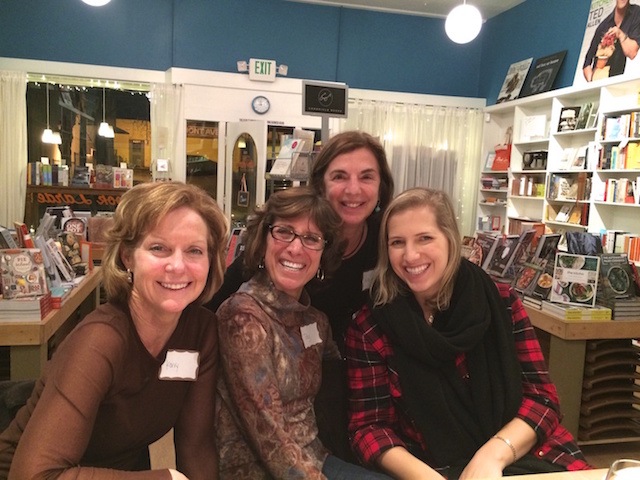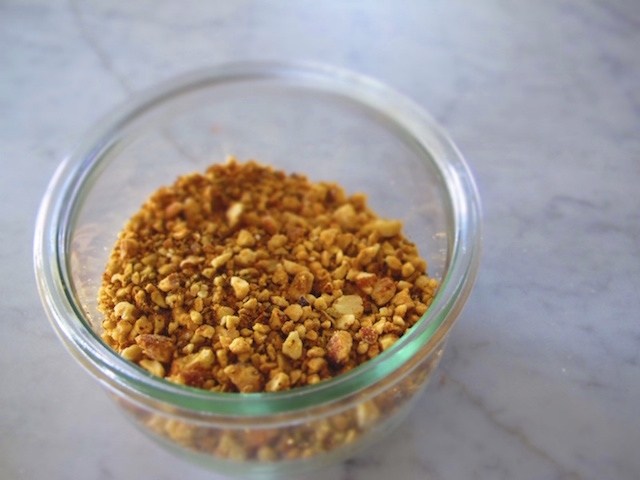Click here to view recipe.
The other week, at the last minute, I spotted a cooking class at one of my favorite haunts in Seattle, The Book Larder. There is a new instructor/chef and he presented a vegetarian menu…a dinner class actually. I roped a couple of friends and my girlfriend’s daughter into accompanying me too.
The “recipes” were just lists of ingredients, although we were told along the way the approximate amounts of each item that was used. For me, I don’t mind winging it … unless I am baking, of course. Once I know the ingredients, I can guesstimate pretty well how much or how little of each ingredient I need to use.
We made and tasted a raw vegetable salad with pomegranate syrup and walnut dressing, roasted garlic and bread soup, roasted carrot/parsnip with harissa, lime and yogurt and Bay Leaf Ice cream with spiced nuts. A great menu, in my opinion and I’ll be trying, modifying and posting a recipe or two once I get myself in gear.
The roasted carrot and parsnip dish especially tickled my fancy, and the presentation was perfect: a shmear of whole milk plain yogurt, the roasted vegetables, harissa sauce and a sprinkle of dukkah. Duck what, you ask? Dukkah! This Egyptian mix of toasted spices, nuts and seasoning transported me back to my New Zealand travels from 2006!
The chef gave us a verbal recipe which wasn’t even part of the class – and on my first try I modified it a bit but pretty much stuck to the ingredients and quantities he suggested: a cup of hazelnuts, spices and ⅓ cup of salt. All was well until I tasted my final product…WAY too salty, even as a sprinkle on top of veggies. WAY TOO MUCH! Back to the drawing board… I found notes I’d taken from a winery in Napier, New Zealand — the first place I ever tasted dukkah. My next try I hit a good, basic mix that is now in my fridge, ready for daily use.
Many dukkah recipes call for black peppercorns, roasted then pounded or processed with everything else. Some of my family members are very sensitive to black pepper for some reason so I omitted this step – but go ahead and add this if you adore black pepper.
Dukkah
Makes 1 ½ cups
Ingredients
- ½ cup whole raw almonds with skins
- ½ cup hazelnuts, skin removed (Note: I bought some that were already roasted and skinned-I suggest you use these if you can find them)
- 2 tablespoons whole cumin seeds
- 1 tablespoon whole coriander seeds
- 1 ½ teaspoons whole caraway seeds
- 2 teaspoons white sesame seeds
- ½ tsp dried oregano
- 1 teaspoon flaked sea salt
Instructions
Preheat oven to 350 degrees.
Spread the hazelnuts on one baking tray (if you don’t already buy them toasted and skinned; if you get them already roasted and skinned, don’t put them in the oven at all).
Place the almonds and cumin, coriander, fennel and sesame seeds on another tray and place both trays in oven about 10 minutes or until nuts and seeds are toasted. If you had to roast the hazelnuts, transfer them to a clean tea towel and rub nuts in tea towel to remove as much of the hazelnut skin as possible; cool.
Once cooled, place all ingredients from the recipe into a food processor and pulse to form fine crumbs. Don’t overdo this or it starts to clump together.
This mixture stays in an airtight jar for a long time in the refrigerator (because of the nuts I refrigerate mine unless I plan to use it within a week).
Get a crusty rustic loaf of warm bread and a bowl of olive oil, then a dish of dukkah so you can tear pieces of bread, dip into olive oil and then coat it a bit with dukkah. Mix some of this into bread crumbs you use to saute fish or chicken. Use a teaspoon to top salads, to garnish roasted vegetables, or sprinkle on eggs. In my humble opinion, dukkah should become a staple in every kitchen!







